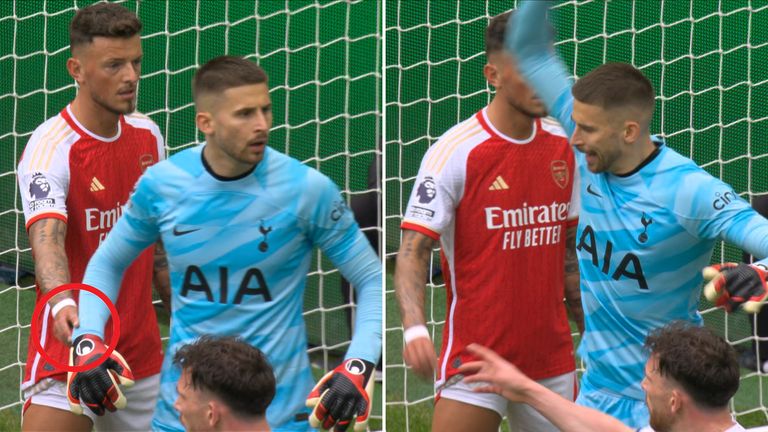
The warning signs were there for Manchester United before Arsenal struck.
With the ball flying out towards an Arsenal corner, Diogo Dalot sprinted to quickly rectify the situation and concede a throw-in instead. “That’s quite important given how good Arsenal are from corners,” said Sky Sports’ Gary Neville on co-commentary duty.
But just 22 seconds later, Dalot could do nothing but concede a corner – and give Arsenal their first set-piece of the Premier League season. And, in classic fashion, they ended up scoring from it.
It was almost inevitable. Like last season, Declan Rice’s delivery was on the money. Like last season, Altay Bayindir was unconvincing in clearing from underneath his own crossbar. Riccardo Calafiori could not miss on the line.
It is a common sight. Since the 2023/24 campaign, the Gunners have scored 31 goals from corners, averaging a goal every 16 attempts.
And given they average just under seven corners a match, it means the chances of them finding the net from a corner lies once every two or three games – if you are lucky.
Arsenal have been regarded as set-piece experts for around 18 months now – but scoring from their first set-piece of this Premier League season is a message to their rivals: put plenty of time and focus on trying to stop this, or they will hurt you.
So how can their Premier League rivals even start to think about stopping them?
Break up their timing
Arsenal’s corner routine begins like any other – with the taker, normally Rice or Bukayo Saka, putting their arm up in the air so the players in the middle know when to start their combinations.
But what those players in the middle are going to do is more unpredictable. Arsenal have had multiple routines but also multiple starting positions. Sometimes the Gunners players group together at the back post but at Old Trafford on Sunday, they all gathered on the edge of the box.
The reason why is to make short runs into the box and create momentum for when the ball arrives in the danger zone. But it also creates a bit of chaos, with opposition players being blocked off from trying to defend the ball.
“They’ve done it for a long period of time in terms of the timing – when they start moving, how they move, when they get to the dangerous area, whether it’s the front or the back post,” set-piece coach Marc Orti Esteban told Sky Sports.
Until last season, Orti Esteban was a set-piece analyst at Brentford before leaving to oversee New England Revolution’s dead-ball department. Working under Keith Andrews, he was tasked with trying to work out how to stop Arsenal from set-pieces.
And his best advice to try to stop that Arsenal chaos? Control it.
“It’s all about breaking their timing and what they do – they are very good at that,” Esteban said.
“If you can stop that with physicality, stopping their runs, making it hard for them to move like they want to do, then you have a better chance of defending that situation.
“It’s about being smart and knowing that they can deliver to the front or the back post. So you have to be covered in those areas.”
Teams have tried that in the past, putting a big focus on trying to halt Gabriel’s run towards the penalty box. The Brazilian defender – who has 17 goals from set-pieces in the last five years – can sometimes be seen hovering in the middle of the penalty area, before attacking the ball with a run from deep.
The only issue with using physicality is Premier League referees are clamping down on that this season. There will be stricter punishments for tugging players back in the penalty area. “I would expect this time next year for there to have been a few more penalties given for holding offences than what we’ve seen this year,” said Howard Webb before this season started.
Arsenal will have to focus on that too, as their ‘blocking’ of defenders will be scrutinised a lot more. So it shows the importance of being street-wise when the Gunners get corners.
The importance of a strong goalkeeper
One of those ‘street-wise’ moments that Arsenal and their opponents have to monitor is how the Gunners players affect the opposition goalkeeper – a factor Manchester United found out on Sunday.
Goalkeeper Bayindir was deemed at fault for Calafiori’s goal, but there was also some clever play involving William Saliba, with the Arsenal defender leaning into the United shot-stopper.
Despite the PGMOL looking to clamp down on holding in the box, the VAR deemed Saliba’s intervention on Bayindir as “normal football contact”.
With Arsenal looking to take advantage of every marginal gain a corner brings, this was another rule they managed to bend in their favour – especially given how they like to attack the six-yard box during corners.
It is not the first time Arsenal have tried and benefited from that tactic.
In the 3-2 north London derby win at Spurs, Ben White was seen doing a similar trick on Guglielmo Vicario – giving the Italian goalkeeper a shove – a bounce off the shoulder – so he would be unable to claim the cross, allowing Kai Havertz to nod in a close-range header.
It has not always worked, especially involving White. The England international tried a similar tactic in a 1-0 win at Leicester in 2023 – holding onto goalkeeper Danny Ward’s glove in the hope that VAR would not catch it. But when Leandro Trossard found the net, it was spotted.
Bending the rules? Yes – but it is something that is seen a lot in Arsenal’s corner routines. So a strong goalkeeper is a must.
Does clearing the penalty area work?
Last season, some teams tried a new defensive corner tactic against Arsenal to help their defenders get to and clear the ball, including their goalkeeper.
Crystal Palace, Brighton, Monaco and Spurs all left two or three players up on the halfway line, meaning Arsenal were forced to leave a few players back. That not only decreases the number of players in and around the penalty box but also creates space for goalkeepers to come and claim the ball.
“Usually they come with six running into the six-yard box, causing a lot of noise and trouble” Crystal Palace boss Oliver Glasner said last season. “They are blocking, pushing, and then it looks like every single ball comes to the spot where they expect it.
“The Man Utd game against Arsenal [where Arsenal scored twice from corners in a 2-0 win], United had eight players in the six-yard box to defend, and I think they could have conceded five.
“We wanted that the box is clearer. It was.”
The only problem? Arsenal still managed to score from a corner against Palace through Havertz. That was because there were fewer defenders on hand to react to the German scoring after the ball came off the post. “We defended the first ball but we didn’t defend the second ball, the rebound,” said Glasner.
“I think it was not an issue of having three players up, it was just that we have to be so sharp in every situation.”
After Palace tried that tactic, Spurs came to the Emirates and attempted something similar – but ended up conceding a goal from a corner themselves as Gabriel forced a Dominic Solanke own goal. It has not been seen again.
So no matter what teams end up coming up with to foil Arsenal, the Gunners keep on scoring. Leeds are their next visitors to the Emirates, with Daniel Farke’s side putting a focus on set-pieces themselves this summer.
All of Leeds’ summer signings are 5ft 11in and above. “It’s not a coincidence,” said Farke – due to the importance of set-pieces in their survival fight. Will they have an answer against one of the biggest individual weapons in the Premier League?
Watch Arsenal vs Leeds live on Sky Sports Premier League this Saturday from 5pm; kick-off 5.30pm
This news was originally published on this post .















Be the first to leave a comment